Getting Started
3 Sep 202015 minutes to read
This section provides you an overview for working with SfSchedule for Xamarin.Android and also provides a walk through to configure SfSchedule control in real time scenario.
Assembly Configuration
You can download our Xamarin components directly from our website, refer here for assistance.
Once the assemblies has been downloaded and explored as mentioned above,you can find all the required assemblies in the installation folders.
{Syncfusion Essential Studio Installed location}\Essential Studio\syncfusionessentialstudio-releaseversion\Xamarin\lib
Eg: C:\Program Files (x86)\Syncfusion\Essential Studio\15.1.0.41\Xamarin\lib
NOTE
Assemblies can be found in unzipped package location in Mac
Adding SfSchedule Reference
Syncfusion Xamarin components are available in nuget.org. To add SfSchedule to your project, open the NuGet package manager in Visual Studio, and search for Syncfusion.Xamarin.SfSchedule, and then install it.

To know more about obtaining our components, refer this link. Also, if you prefer to manually refer the assemblies instead of NuGet,refer the assembly mentioned in the table below.
| Project | Required assembly |
|---|---|
| Xamarin.Android | android\Syncfusion.SfSchedule.Android.dll |
Important
Starting with v16.2.0.x, if you reference Syncfusion assemblies from trial setup or from the NuGet feed, you also have to include a license key in your projects. Please refer to this link to know about registering Syncfusion license key in your Xamarin application to use our components.
Create a simple application with SfSchedule
This section explains how to create a simple application using SfSchedule control. SfSchedule control can be configured entirely in C# code. This is how the final output will look like on Android devices.
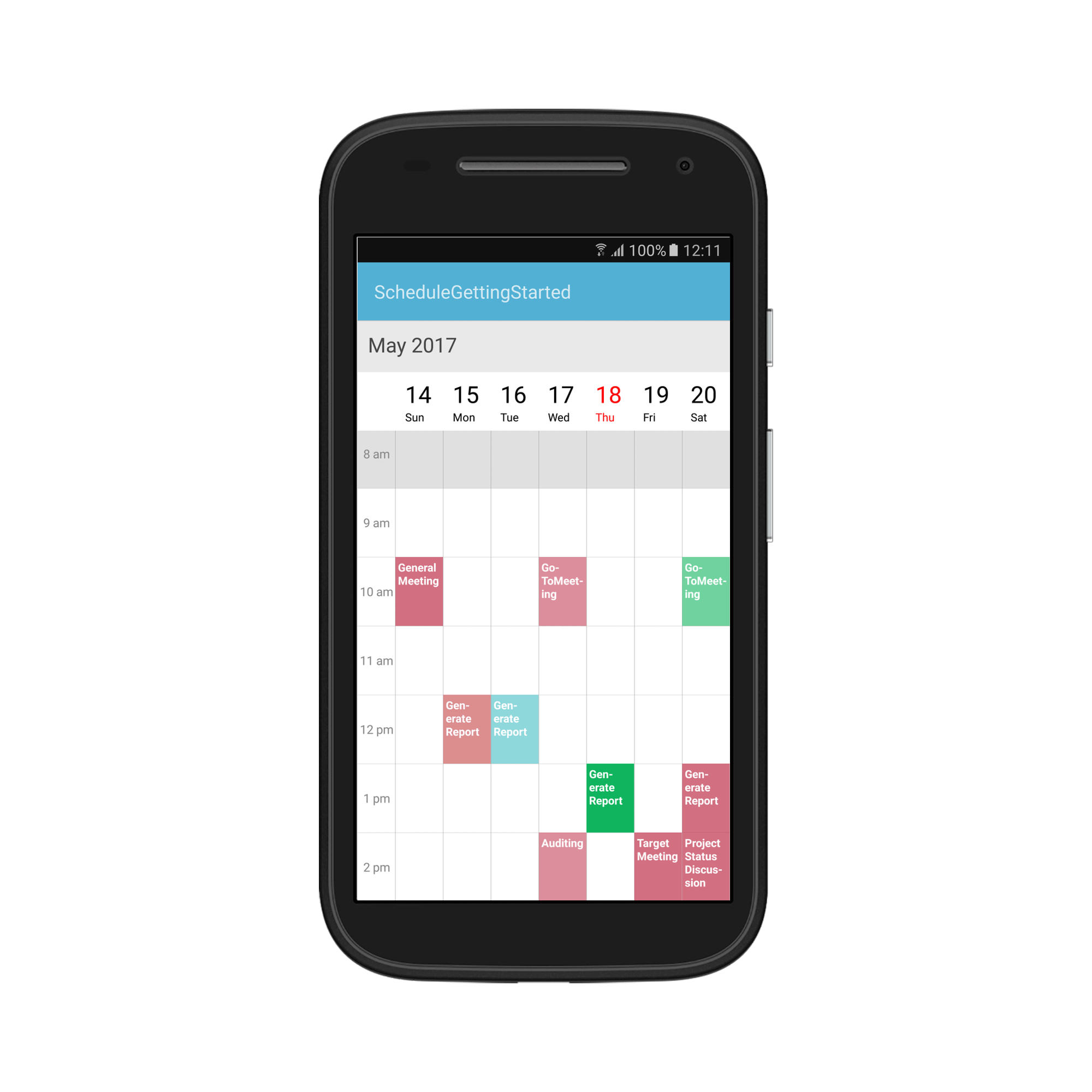
You can download the entire source code of this demo for Xamarin.Android from
here ScheduleGettingStarted.
This section provides a walks through to create MeetingRoomScheduler using our Schedule control.
- Creating a new project
- Adding SfSchedule to the project
- Changing Schedule Views
- Binding data to SfSchedule control
Creating a new project
Create a new Android application in Xamarin Studio or Visual Studio for Xamarin.Android.
Add the required assembly references to the project as discussed in the Assembly Configuration section.
Import SfSchedule control namespace Syncfusion.SfSchedule.Android.
Adding SfSchedule to the project
Create an instance of SfSchedule control and add as a child to the view hosted in the Activity.
using Syncfusion.SfSchedule.Android;
SfSchedule schedule;
protected override void OnCreate(Bundle bundle)
{
base.OnCreate(bundle);
//Creating new instance for SfSchedule
schedule = new SfSchedule(this);
SetContentView(schedule);
}Changing Schedule Views
SfSchedule control provides five different types of views to display dates and it can be assigned to the control by using ScheduleView property. By default the control is assigned with DayView.Current date will be displayed initially for all the Schedule views.
Schedule control will be rendered with Sunday as the first day of the week, but you can customize to any day by using FirstDayOfWeek property of SfSchedule.
//setting first day of the week
schedule.FirstDayOfWeek = Calendar.Tuesday;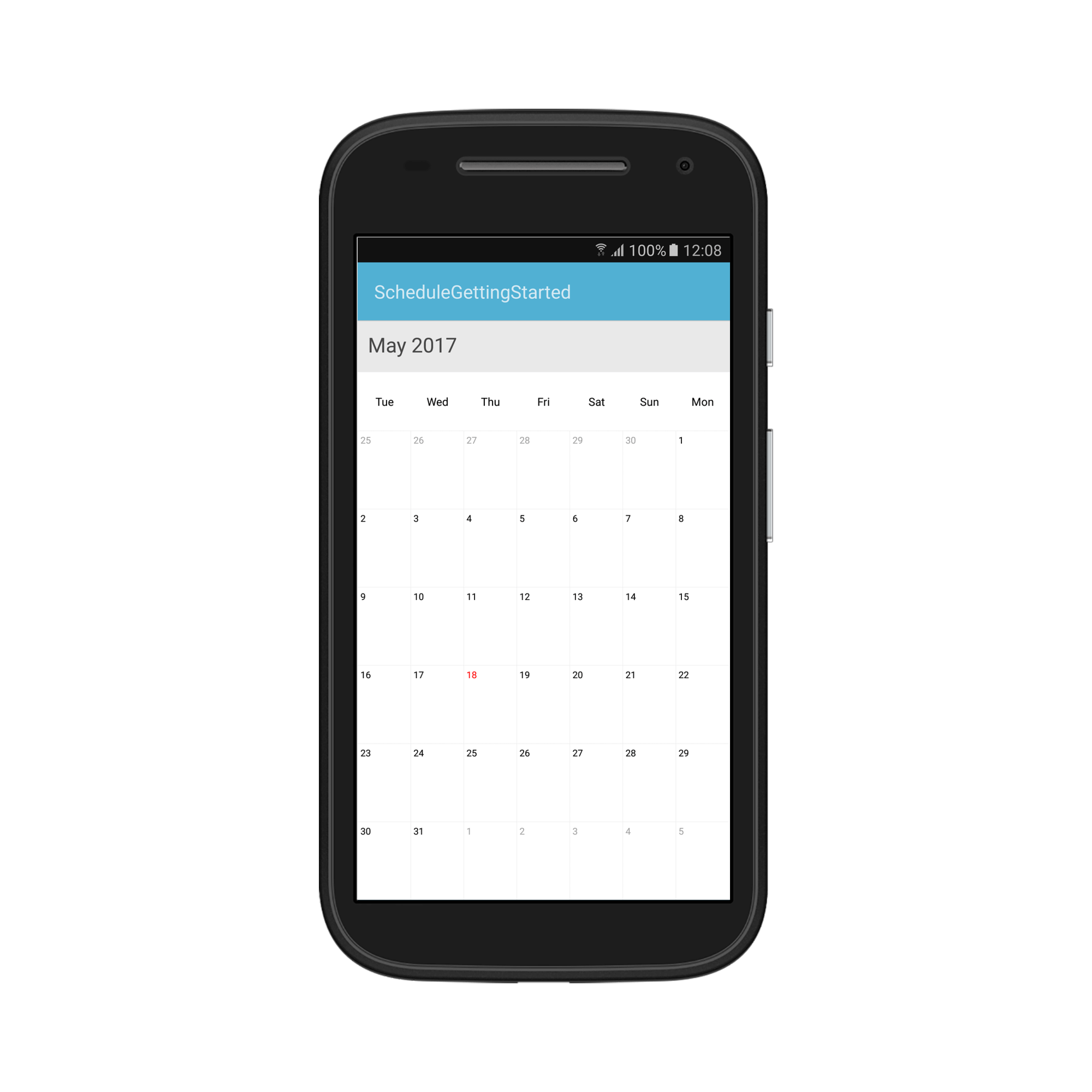
Day View
DayView is used to display a single day, current day will be visible by default. Appointments on a specific day will be arranged in respective timeslots based on its duration.
//setting schedule view
schedule.ScheduleView = ScheduleView.DayView;
Week View
WeekView is to view all days of a particular week. Appointments will be arranged based on the dates on the week in respective timeslots.
//setting schedule view
schedule.ScheduleView = ScheduleView.WeekView;
Work Week View
WorkWeekView is to view only working days of a particular week. By default, Saturday and Sunday are the non-working days. You can be customize it with any days of a Week. Appointments arranged in timeslots based on its duration with respective day of the week.
//setting schedule view
schedule.ScheduleView = ScheduleView.WorkWeekView;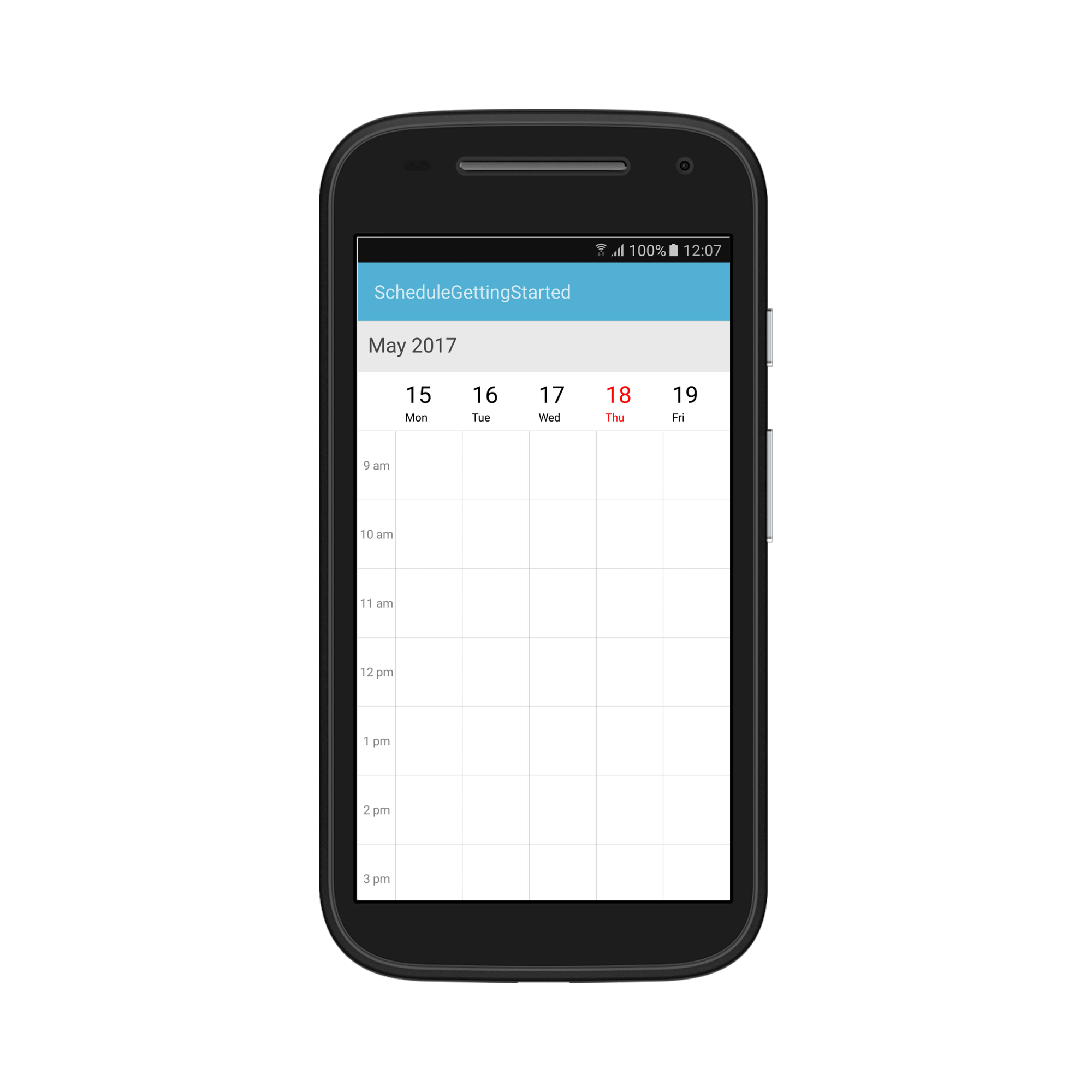
NOTE
Appointments in non-working days will not be displayed.
Timeline view
TimelineView displays the dates in horizontal time axis with the desired day’s count. You can see the past or future dates by scrolling to the right or left. Each view displays events accurately across the time slots with an intuitive drag-and-drop feature.
schedule.ScheduleView = ScheduleView.Timeline;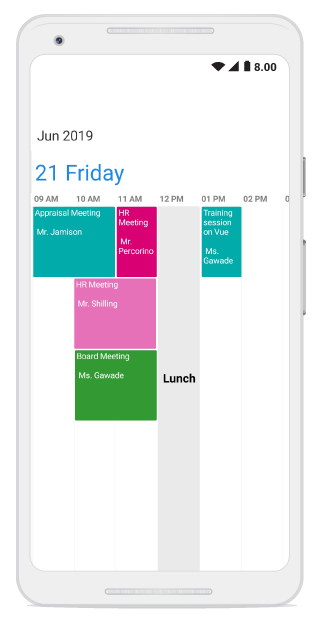
Month View
MonthView in Schedule control is to view entire dates of a particular month. Appointments can be viewed in inline by setting ShowAppointmentsInline property of MonthViewSettings of SfSchedule as true.
//setting schedule view
schedule.ScheduleView = ScheduleView.MonthView;
schedule.MonthViewSettings.ShowAppointmentsInline = true;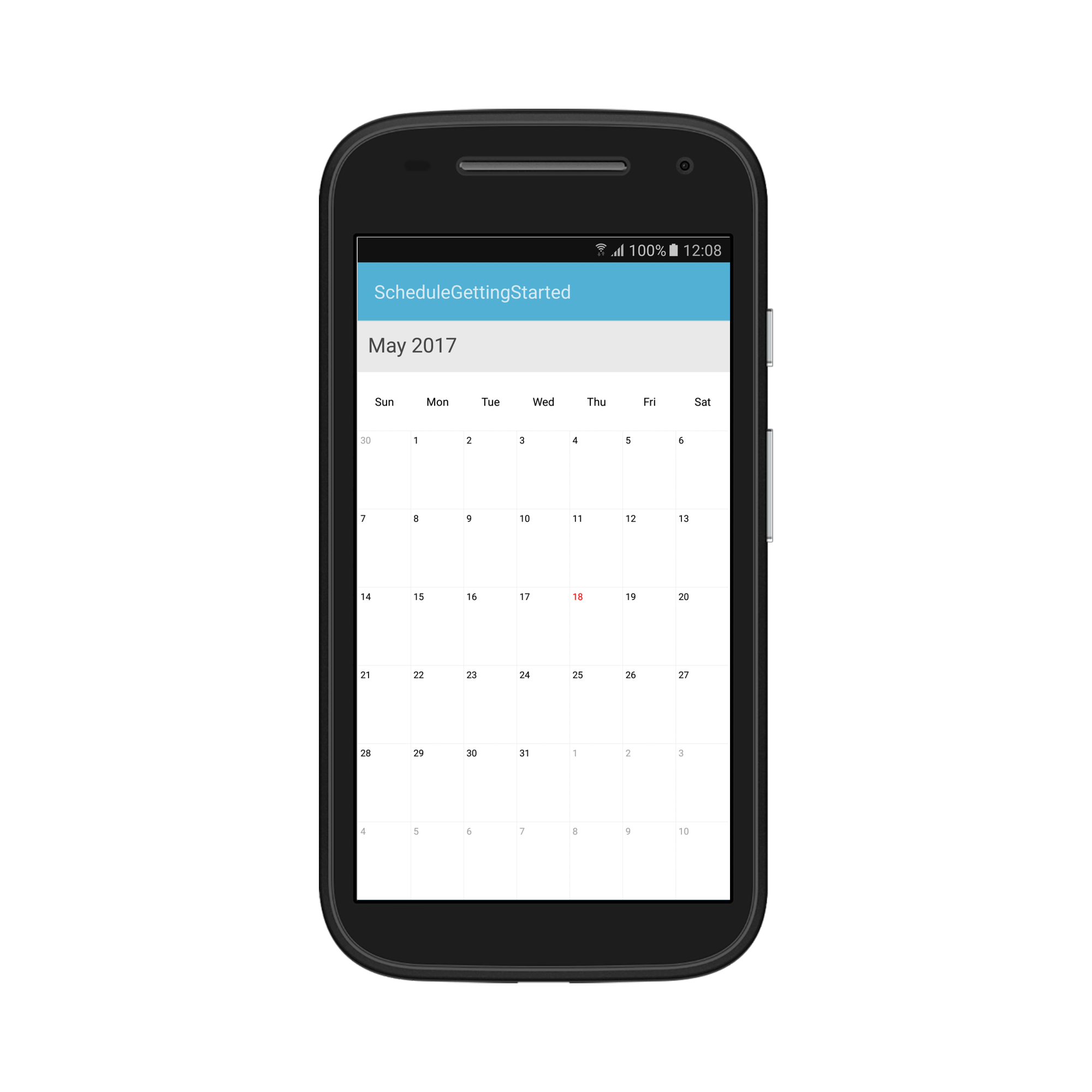
Binding data to SfSchedule control
You can add events to the schedule by creating collection of ScheduleAppointment using ScheduleAppointmentCollection.
Adding Appointments
ScheduleAppointment is a class, which holds the details about the appointment to be rendered in schedule. It has some basic properties such as StartTime, EndTime, Subject and some additional information about the appointment can be added using Color, Notes, Location, IsAllDay, IsRecursive properties.
Here are steps to render MeetingRoomScheduler using SfSchedule control.
Adding data for class
Adding event names
You can add Subject to the appointments created by creating a collection for the same.
List<string> subjectCollection;
/// <summary>
/// Creates subject collection.
/// </summary>
private void CreateSubjectCollection()
{
subjectCollection = new List<string>();
subjectCollection.Add("GoToMeeting");
subjectCollection.Add("Business Meeting");
subjectCollection.Add("Conference");
subjectCollection.Add("Project Status Discussion");
subjectCollection.Add("Auditing");
subjectCollection.Add("Client Meeting");
subjectCollection.Add("Generate Report");
subjectCollection.Add("Target Meeting");
subjectCollection.Add("General Meeting");
subjectCollection.Add("Pay House Rent");
subjectCollection.Add("Car Service");
subjectCollection.Add("Medical Check Up");
subjectCollection.Add("Wedding Anniversary");
subjectCollection.Add("Sam's Birthday");
subjectCollection.Add("Jenny's Birthday");
}Adding color collection
You can add Color to the appointments created by creating a collection for the same.
List<string> colorCollection;
/// <summary>
/// Creates color collection.
/// </summary>
private void CreateColorCollection()
{
colorCollection = new List<string>();
colorCollection.Add("#117EB4");
colorCollection.Add("#B4112E");
colorCollection.Add("#C44343");
colorCollection.Add("#11B45E");
colorCollection.Add("#43BEC4");
colorCollection.Add("#B4112E");
colorCollection.Add("#C44343");
colorCollection.Add("#117EB4");
colorCollection.Add("#C4435A");
colorCollection.Add("#DF5348");
colorCollection.Add("#43c484");
colorCollection.Add("#11B49B");
colorCollection.Add("#C44378");
colorCollection.Add("#DF8D48");
colorCollection.Add("#11B45E");
colorCollection.Add("#43BEC4");
}Populating data collection
Schedule control has a built-in capability to handle the appointment arrangement internally based on the ScheduleAppointment collections.
ScheduleAppointmentCollection Meetings;
int workStartHour = 9;
/// <summary>
/// Creates meetings and stores in a collection.
/// </summary>
private void CreateAppointments()
{
Meetings = new ScheduleAppointmentCollection();
Java.Util.Random randomTime = new Java.Util.Random();
CreateSubjectCollection();
CreateColorCollection();
Calendar calendar = Calendar.Instance;
Calendar DateFrom = Calendar.Instance;
DateFrom.Add(CalendarField.Date, -10);
Calendar DateTo = Calendar.Instance;
DateTo.Add(CalendarField.Date, 10);
Calendar dateRangeStart = Calendar.Instance;
dateRangeStart.Add(CalendarField.Date, -3);
Calendar dateRangeEnd = Calendar.Instance;
dateRangeEnd.Add(CalendarField.Date, 3);
for (calendar = DateFrom; calendar.Before(DateTo); calendar.Add(CalendarField.Date, 1))
{
if (calendar.After(dateRangeStart) && calendar.Before(dateRangeEnd))
{
for (int AdditionalAppointmentIndex = 0; AdditionalAppointmentIndex < 3; AdditionalAppointmentIndex++)
{
ScheduleAppointment meeting = new ScheduleAppointment();
int hour = workStartHour + randomTime.NextInt(9);
Calendar startTimeCalendar = Calendar.Instance;
startTimeCalendar.Set(calendar.Get(CalendarField.Year),
calendar.Get(CalendarField.Month),
calendar.Get(CalendarField.Date),
hour, 0);
meeting.StartTime = startTimeCalendar;
Calendar endTimeCalendar = Calendar.Instance;
endTimeCalendar.Set(calendar.Get(CalendarField.Year),
calendar.Get(CalendarField.Month),
calendar.Get(CalendarField.Date),
hour + 1, 0);
meeting.EndTime = endTimeCalendar;
meeting.Color = Color.ParseColor(colorCollection[randomTime.NextInt(9)]);
meeting.Subject = subjectCollection[randomTime.NextInt(9)];
Meetings.Add(meeting);
}
}
else
{
ScheduleAppointment meeting = new ScheduleAppointment();
int hour = workStartHour + randomTime.NextInt(9);
Calendar startTimeCalendar = Calendar.Instance;
startTimeCalendar.Set(calendar.Get(CalendarField.Year),
calendar.Get(CalendarField.Month),
calendar.Get(CalendarField.Date),
hour, 0);
meeting.StartTime = startTimeCalendar;
Calendar endTimeCalendar = Calendar.Instance;
endTimeCalendar.Set(calendar.Get(CalendarField.Year),
calendar.Get(CalendarField.Month),
calendar.Get(CalendarField.Date),
hour + 1, 0);
meeting.EndTime = endTimeCalendar;
meeting.Color = Color.ParseColor(colorCollection[randomTime.NextInt(9)]);
meeting.Subject = subjectCollection[randomTime.NextInt(9)];
Meetings.Add(meeting);
}
}
}Setting appointments for SfSchedule
Create meetings of type ScheduleAppointmentCollection and assign those appointments collection Meetings to the ItemsSource property.
CreateAppointments();
schedule.ItemsSource = Meetings;